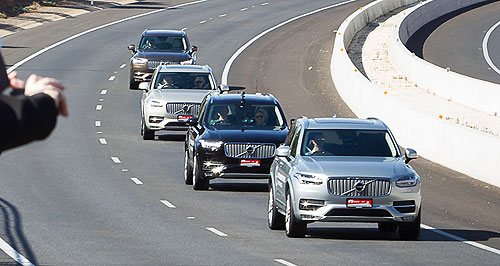Make / Model Search
News - General News - Autonomous TechnologyAustralian laws not able to cope with driverless carsFlashing lights: Unless the law is clear, different levels of vehicle automation and responsibility of occupants in a driverless car could make it difficult for police officers to determine who is responsible for traffic offences. Tricky, slow road ahead for autonomous cars in Australia without major law reform19 May 2016 By TERRY MARTIN THE National Transport Commission (NTC) has released a discussion paper that highlights the barriers to increasing vehicle automation and is calling for further submissions as it lays the groundwork for updating Australia’s transport laws to accommodate driverless cars. Making it clear that Australia’s laws are nowhere near ready for the advent of self-driving cars, the NTC has raised a number of questions that need to be resolved in order to support further pilot programs and, in the longer term, enable fully autonomous vehicles onto our roads when they become available from as early as 2020. These include: How can governments enable on-road trials of automated vehicles nationally? How can governments help clarify who is controlling a vehicle when the human driver is not driving? Or when control can alternate between a human and an automated driving system?Furthermore, how should the requirement that a driver must have proper control of a vehicle be interpreted by police when there is no human driver?And what should happen to the range of laws that put obligations on a human driver of a vehicle, such as rendering assistance after a crash, complying with directions from police or paying any tolls or fines incurred?The NTC also says it is not clear whether people injured in a crash with an automated vehicle will always be able to claim insurance under compulsory third-party insurance or state-based accident compensation schemes. “Australia’s laws need to be ready for the biggest change to our transport system since cars replaced horses,” said NTC chief executive Paul Retter. “Amending these laws shouldn’t be hard, but making sure the new laws are nationally consistent and encourage innovation while ensuring the safety of all road users will be important. “The NTC will take recommendations to Australia’s transport ministers when they meet in November. Stakeholders now have the opportunity tell us how to make sure we have the best possible national laws for our national economy and our local communities.” There is a sense of urgency for regulatory reform given automated vehicles that share the driving task with humans are expected to be available in Australia within the next few years. However, Mr Retter cautioned that there were risks in trying to rush ahead and amend vehicle standards for fully automated vehicles (such as driverless pods) “without first addressing existing barriers to the types of automated vehicles that we are likely to be see on our roads in the near future”. The discussion paper has emerged three months after the NTC released an issues paper on driverless cars and called for submissions on how best to shape and manage laws that will govern them. It received 32 responses to the initial call, and is now offering another opportunity – until July 4 – for interested parties to provide feedback on key issues that have been identified from a national legal audit of all relevant legislation and the initial submissions from stakeholders. The priority barriers to be addressed in the near term (that is, as soon as possible) include: potentially inconsistent rules for on-road trials in states and territories lack of clarity as to who or what is in control of a vehicle that is conditionally automated (does the driver still need to pay attention to the outside world once the car is placed into autonomous mode?) and lack of clarity as to what ‘proper control’ means for conditionally and highly automated vehicles. In the medium term (reforms commencing within two years), barriers include: the absence of regulatory mechanisms to ensure automated vehicles are operated safely by an automated vehicle ‘system entity’ (driver licencing, for example, will not be required in cars that do not have a human driver) the definition of ‘driver’ in many laws requires a human driver some obligations of the driver cannot be met by an automated vehicle (drink driving and fatigue, for instance) and it could be difficult to identify who is responsible for a highly automated vehicle when control can alternate between the human driver and automated driving system. In the longer term (commencing in three-to-five years), the main barrier to address is that current vehicle standards assume a human driver, but once fully autonomous vehicles hit the road they are unlikely to have driver-related features currently required under Australian Design Rules (ADRs) such as steering wheels, control panels, rearview mirrors and brake pedals. The NTC has also identified a number of issues that would benefit from clarification now, but could be adapted over time. These include: vehicle modifications in highly and fully automated vehicles could be a higher risk lack of clarity as to who is liable for a crash and a potential or perceived threat to privacy.  Read more |
Click to shareGeneral News articlesResearch General News Motor industry news |











Facebook Twitter Instagram